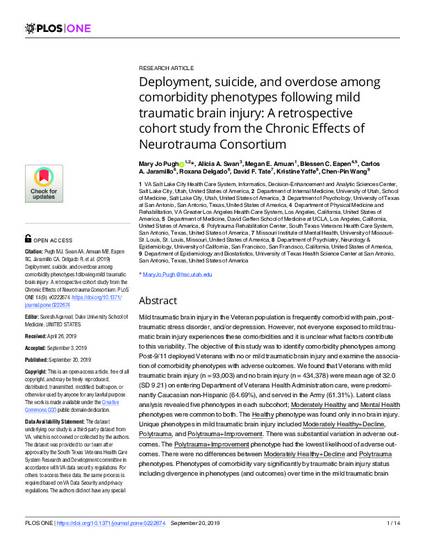
Article
Deployment, suicide, and overdose among comorbidity phenotypes following mild traumatic brain injury: A retrospective cohort study from the Chronic Effects of Neurotrauma Consortium.
PLOS ONE
(2019)
Abstract
Mild traumatic brain injury in the Veteran population is frequently comorbid with pain, post-traumatic stress disorder, and/or depression. However, not everyone exposed to mild traumatic brain injury experiences these comorbidities and it is unclear what factors contribute to this variability. The objective of this study was to identify comorbidity phenotypes among Post-9/11 deployed Veterans with no or mild traumatic brain injury and examine the association of comorbidity phenotypes with adverse outcomes. We found that Veterans with mild traumatic brain injury (n = 93,003) and no brain injury (n = 434,378) were mean age of 32.0 (SD 9.21) on entering Department of Veterans Health Administration care, were predominantly Caucasian non-Hispanic (64.69%), and served in the Army (61.31%). Latent class analysis revealed five phenotypes in each subcohort; Moderately Healthy and Mental Health phenotypes were common to both. The Healthy phenotype was found only in no brain injury. Unique phenotypes in mild traumatic brain injury included Moderately Healthy+Decline, Polytrauma, and Polytrauma+Improvement. There was substantial variation in adverse outcomes. The Polytrauma+Improvement phenotype had the lowest likelihood of adverse outcomes. There were no differences between Moderately Healthy+Decline and Polytrauma phenotypes. Phenotypes of comorbidity vary significantly by traumatic brain injury status including divergence in phenotypes (and outcomes) over time in the mild traumatic brain injury subcohort. Understanding risk factors for the divergence between Polytrauma vs. Polytrauma+Improvement and Moderately Healthy vs. Moderately Healthy+Decline, will improve our ability to proactively mitigate risk, better understand the early patterns of comorbidity that are associated with neurodegenerative sequelae following mild traumatic brain injury, and plan more patient-centered care.
Disciplines
Publication Date
September 20, 2019
DOI
10.1371/JOURNAL.PONE.0222674
Publisher Statement
Copyright: This is an open access article, free of all copyright, and may be freely reproduced, distributed, transmitted, modified, built upon, or otherwise used by anyone for any lawful purpose. The work is made available under the Creative Commons CC0 public domain dedication
Citation Information
Mary Jo Pugh, Alicia A. Swan, Megan E. Amuan, Blessen C. Eapen, et al.. "Deployment, suicide, and overdose among comorbidity phenotypes following mild traumatic brain injury: A retrospective cohort study from the Chronic Effects of Neurotrauma Consortium." PLOS ONE Vol. 14 Iss. 9 (2019) Available at: http://works.bepress.com/tate-david/82/
Creative Commons license

This work is licensed under a Creative Commons CC_BY International License.
